Are you struggling to lose that extra flab and all those nasty calories that seem to be glued to your waistline? Do you ever wonder why, despite your hard training and dieting, you still have those annoying love handles? Then maybe you should try to implement the NEAT way to fat loss…
Printer friendly version
(Right click to download and save to your computer. The pdf version has more references)
NEAT – the ignored component of physical activity, metabolic regulation and total daily caloric expenditure
When it comes to fat loss, a key is to increase your energy expenditure. Therefore, the traditional prescription for fat loss has focused on exercise as a means of revving up your energy expenditure to burn off excess fat. While exercise (both cardio and weight lifting) is essential for fat loss, there is one other less known, albeit important, component of total daily energy expenditure that could be the missing link in your fat loss endeavor. Enter NEAT…
NEAT stands for non-exercise activity thermogenesis (or non-exercise activity energy expenditure). NEAT is the energy expenditure induced by non-exercise bodily movements in daily life, ie lifestyle embedded physical activity 1.
The term “physical activity” represents the full spectrum of movement, with “exercise” being a subcategory representing the higher end of this spectrum 2. The remainder that falls below the exercise threshold is “non-exercise physical activity”, and is illustrated in the graphic below.
Sedentary behaviors (typically in the contexts of television viewing, computer use, workplace sitting, and time spent commuting) are a new focus for research in the physical activity and health field. As will be outlined below, emerging evidence is showing that there is a physiological distinction between too little exercise vs. too much sitting, i.e. exercise deficiency and sitting excess are each unique states with difference health consequences.
Sedentary behaviors include sitting during commuting, in the workplace and domestic environment, and during leisure time. Actually, the word “sedentary” comes from the Latin “sedere”, which means “to sit’. Sedentary behaviors, a.k.a inactivity, are defined by both posture (sitting or reclining) and low energy expenditure; they don’t elevate energy expenditure substantially above the resting level. In other words, sedentary “activities” incur an energy expenditure at the level close to 1 – 1.5 metabolic equivalent unit (METs). This can be compared to moderate/vigorous physical activity, or “exercise” such as brisk walking or running, which elevates energy expenditure 3-10 times resting metabolic rate, i.e. 3–10 METs.
Inactivity and sedentary behavior is characterized by sitting, reclining and lying down, which doesn’t elevate energy expenditure substantially above the resting level 3. In other words, sedentary activities incur an energy expenditure at the level close to 1 metabolic equivalent unit (METs) 4.
One MET is the energy cost of resting quietly, often defined as 1 cal/kg/hour (or 1 cal per 2.2 lb per hour) 4. To find out your “resting hourly burn rate”, ie how many calories you burn resting per hour, just divide your weight in lb by 2.2. For ex. a person weighing 150 lb will burn 68 cal (150 lb / 2.2), another person weighing 220 lb will burn 100 cal (220 lb / 2.2). It’s a rough estimate, but you get the idea.
Different activities elevate caloric expenditure over resting level as follows: 5
Sitting still 3.7 %
Sitting while fidgeting 54 %
Standing still 13 %
Standing while fidgeting 94 %
Slow strolling 154 %
Fast strolling 202 %
Even though standing still doesn’t markedly elevate caloric expenditure over sitting still, it is not considered to be a sedentary activity because muscle activity in the legs during standing is 2.5 times higher than during sitting 6. During standing, postural muscles (predominantly in the legs) are continually contracting to keep the body upright and maintain balance. This muscle activity during standing in turn stimulates an enzyme called muscle lipoprotein lipase (LPL) 7. LPL is the rate-limiting enzyme for the breakdown of fats circulating in the blood stream, and uptake of free fatty acids into muscle for use as energy (that is, fat burning) 7-11. LPL has been studied heavily because this enzyme has a central role in several aspects of fat metabolism 10,11. LPL also has a major influence on the partitioning of fatty acids between different tissues, plasma cholesterol metabolism and the subsequent downstream intracellular effects related to fat availability 10,11. Thus, the differences between standing and sitting aren’t trivial. More on muscle LPL below.
NEAT vs. Sitting Time
Inactivity and non-exercise activity have gained growing attention because the proportion of time spent doing purposeful exercises usually make up only a fraction of the day, leaving much time for sedentary activities 7. Assuming 8 hours of sleep, we have 16 hours per day at our disposal. Studies that objectively measured physical activity show that people in the US on average spend about 8 hours daily, ie half of their waking time, being sedentary 12. Those employed in sedentary occupations are sedentary for approximately 11 hours per day 13. The graphic below illustrates the major contexts for sedentary behavior and their distribution over a typical adult’s waking hours.
Therefore, it is no wonder that individual differences in light physical activity outside of intense exercise have greater influence on inactivity time than the time we spend exercising 6. This was confirmed in another study where some individuals participated in substantial amounts of intense exercise but otherwise had a relatively low overall daily physical activity energy expenditure 14. Thus, even when adhering to the exercise guidelines recommending at least 30 min/day of moderate-to-vigorous intensity activity at least 5 days per week 15, this does not automatically mean that people will not engage in excessive “baseline” sitting over the rest of the day. Because of this large amount of time we have at our disposal outside of formal exercise time, whether you spend most of your non-exercising time sitting, reclining, or standing and moving around, is a significant issue. this is underscored by the finding that 1 hour of daily physical exercise cannot compensate the negative effects of inactivity on insulin level and blood lipids if the rest of the day is spent sitting 16. And as outlined below, too much inactive sitting can be what’s missing in your fat loss equation…
NEAT – small things add up fast in favor of fat gain or fat loss
This is true for both credit cards and energy expenditure. Energy expended during the day, outside of typical exercise (standing, fidgeting like movements while seated and while standing, ambulation) can vary by up to 2000 calories per day between individuals 14,17,18, and thus may substantially contribute to the daily energy expenditure 5,14,19. This can be explained by the very large variability between people in total inactivity times, ranging from 40 to 91% 6.
It have been estimated that energy demands have dropped by over 400-500 cal/day due to occupational and domestic computerized environments, mechanization, and TV/media 20. Therefore, even one hour of daily exercise might not be enough to achieve fat loss or fat gain prevention 21,22.
What does research say about NEAT as a tool to keep body fat under control?
Caloric expenditure
To examine NEAT’s role in obesity, a study recruited 10 lean and 10 mildly obese sedentary people and measured their body postures and movements every half-second for 10 days 23. The measurements were made using micro-sensors that subjects wore under their clothes and allowed body postures and movements to be accurately measured. It was found that obese individuals were seated 2.7 hours more per day than lean individuals. It was concluded that if obese individuals adopted the NEAT-enhanced behaviors of their lean peers, they might expend an additional 350 calories per day 23, as illustrated in the following diagram:
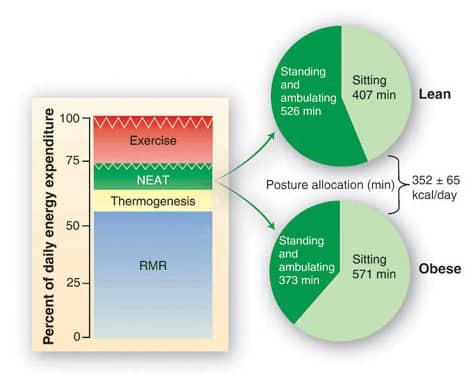
This was confirmed in a later study which compared activity energy expenditure and daily activity patterns (using accelerometes) in lean and obese people 24. It was found that obese women sat 2.6 h more each day (12.7 h vs. 10.1), stood 2 h less (2.7 h vs. 4.7 h) and spent half as much time in moving around activity than lean women (2.6 h vs. 5.4 h) 24. After controlling for differences in fat-free mass, the lean subjects expended 400 calories more per day than the less active and more sedentary obese subjects 24.
It is interesting to note that this difference in magnitude of caloric expenditure between NEATers and non-NEATers is about the same as the formal exercise prescription dose that obese people are urged to adopt in order to induce a negative energy balance and fat loss (2500 cal/wk or 360 cal/day, corresponding to 75 min of brisk walking/d) 25,26. Thus, NEATing like standing/ambulating/fidgeting is of substantial importance for controlling body fat.
Interesting Statistics
Another study found that time spent watching TV is associated with risk of obesity and type 2 diabetes 27. After adjusting for age, smoking, exercise levels and dietary factors, the following risk percentages were documented:
Each 2 hours/d increment in TV watching is associated with:
– 23% increase in obesity and a 14% increase in risk of diabetes.
Each 2 hours/d increment in sitting at work is associated with:
– 5% increase in obesity and a 7% increase in diabetes.
In contrast, standing or walking around at home (2 hr/d) is associated with:
– 9% reduced risk for obesity and a 12% reduced risk for diabetes.
Each 1 hour per day of brisk walking is associated with:
24% reduced risk for obesity and a 34% reduced risk for diabetes.
In this study population, it was estimated that 30% of new cases of obesity and 43% (95% CI, 32%-52%) of new cases of diabetes during a 6 year follow up could be prevented by adopting a relatively active lifestyle (less than 10 hr/wk of TV watching and at least 30 min/day of brisk walking) 27. Many other studies support the association between sitting time and body fat gain 22,28-35.
Waistline
Sedentary time is also deleteriously associated with a number of cardiovascular risk factors, including waist circumference, blood glucose, and blood fats 36-38. Each 10% increase in sedentary time has been associated with a 1.2 inch (3.1cm) larger waist circumference 36. The association between sedentary time and waist circumference is largely independent of exercise participation 38. 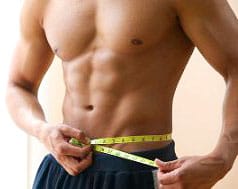
Not just total sitting time, but also breaks in sitting time are important. Compared to those who during the day have fewest breaks per hour of sitting, those with the most breaks per hour of sitting have been found to have 1.6 – 2.34 inches (4.1 – 5.95 cm) smaller waist circumferences 65,66. Of importance to note is that a break could be as short as 1 min and doesn’t have to be intense type “exercise”, suggesting that regular breaks from sitting time can be easily implemented both during the working day and at home. A walk to the kitchen to take a sip of water, or walking around while drinking your coffee/tee, might be enough.
Thus, patterns of sedentary time accumulation are important in addition to total amount of sedentary time.
NEAT – your weapon against vacation and holiday fat gain
We all know about those lucky folks who magically appear to resist fat gain with overeating. These subjective observations have been confirmed in studies that documented a several-fold inter-individual variation in fat accumulation with overeating 39-41. But what is it that makes those people resistant to fat gain?
To answer this question, a study was designed to find out if there is a component of energy expenditure that shows enough variability to account for the variability in resistance to fat gain during overfeeding 42. Non-obese volunteers were fed 1000 calories per day in excess of weight-maintenance requirements for 8 weeks. It was found that fat gain varied over 10-fold, ranging from a gain of only 0.8 lb (0.36 kg) to a gain of 9.3 lb (4.23 kg), and that it was changes in NEAT that accounted for this enormous difference. The maximum increase in NEAT was close to 700 kcal/day, and could be accounted for by an increase in strolling-equivalent activity by about 15 min/hour during waking hours.
It could be argued that it is the obese state that causes declines in NEAT. In order to find out whether differences in NEAT are a cause or consequence of obesity, the same obese subjects were put on a diet for 2 months which caused a weight loss of 17.6 lb (8 kg) 42. However, despite the weight loss, the original NEAT activities were maintained. This indicates that NEAT can be an inherent trait that causes some people to be more spontaneously active than others, and that a low NEAT that contributes to obesity.
The fact that NEAT is a mediator of the resistance to fat gain with overfeeding underscores its power. When people overeat, activation of NEAT dissipates a large part of the excess energy to preserve leanness, while failure to activate NEAT results in fat gain. Those who with overfeeding increase their NEAT the most, gain the least fat. Those who with overfeeding do not increase their NEAT gain the most fat and are predisposed to become obese.
Because the human genetic code has not changed during the past 50 years while obesity has become epidemic, obesity may in part be a consequence of enhanced responsiveness to environmental cues to be seated. But just because you don’t have an innate NEAT drive doesn’t mean you’re lost. Knowing the importance of NEAT as an anti-fat gain weapon, you can cognitively override your gravitation to the chair and consciously decide to simply move around more in your daily life.
Sitting – not just simply the opposite of exercising
Intuitively, sitting might be interpreted as the opposite of exercise, or lack of exercise. However, these two different behaviors each have unique effects, and therefore have to be treated separately. One molecular reason to maintain daily low-intensity ambulating activity is its importance for LDL regulation 8, as mentioned above. Muscle LPL activity is especially important since it is a prerequisite for the uptake and subsequent burning of fat that has been released from body fat stores.
What is intriguing is that sitting, low intensity ambulatory physical activity and high intensity exercise all have difference effects on muscle LPL activity 7. For example, the reduction in muscle LPL activity in response to sitting is largely restricted to oxidative muscle fibers, while increases in LPL activity in response to exercise is mainly occurring in glycolytic muscle fibers. Further, the relative decreases in LPL activity seen in oxidative fibers following sitting are more than 4-fold greater than the increases observed in glycolytic fibers following vigorous exercise 7,8,43.
It is notable that almost all of the LPL activity normally present in the capillaries (small blood vessels) of muscles is dependent upon low-intensity ambulatory activity 8. Muscle LPL activity decreases during inactivity and is very sensitive to non-fatiguing low intensity contractions, which rapidly reverse the sitting induced reduction in LPL activity 8. Thus, it is a misconception to think that ordinary spontaneous low-grade movements and weight-bearing activities in daily life are insufficient to elicit specific and notable physiological effects. This is underscored by the finding that those who do not exercise but have a high NEAT have a larger reduction in mortality risk thank those who partake in exercise but have low NEAT 44. 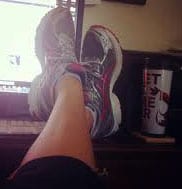
This means that an “active couch potato” might actually be healthier than a “lazy exerciser”. Further support for the independence of sitting and exercise habits in daily life is that the correlation between the two is very weak 36, meaning that one doesn’t necessarily follow the other in the same direction. In other words, going to the gym is no excuse for spending the rest of your day on the couch.
Even if you exercise, sitting can be what’s halting your fat loss…
The fact that the mechanism linking LPL activity to sitting is distinct from that linking LPL activity to exercise, underscores the importance of viewing exercise and sitting as two separate factors influencing fat loss efforts and health outcomes. Too much sitting is not the same as too little exercise.
This is supported by evidence showing that sitting time increases the risk for expanded waistlines, obesity, insulin resistance, cardio-metabolic disturbances, cardiovascular disease and all-cause mortality independent of participation in exercise 21,22,27,34,36,45-62.
For example, even among the most active people (those exercising at moderate-vigorous intensity for 60 min/day), spending 2- 4 hours per day in sedentary time (television viewing and screen-based entertainment) more than doubles the risk for obesity compared to spending less than 2 hours/day in sedentary pursuits 63. Compared with people who watch television or videos or use a computer less than 1 h/d outside of work, the risk for the metabolic syndrome (which is a constellation of risk factors, including an expanded waistline) increases by 37 %, 70 % and 210 % for 2, 3 and 4 or more hours/day respectively, regardless of physical activity level 52.
Because the time spent in sedentary behaviors has been shown to be independent of exercise in population research, a recent study sought to examine within an individual whether exercise alters the time of muscular inactivity within his/her usual daily life 64. Quadriceps and hamstring muscle activities (EMG recordings) and heart rate were measured during 6 days of normal daily living of ordinary people. Reported exercises varied from Nordic walking (aka. pole walking, a high intensity type of walking) to strength training and ball games lasting 30-150 min. It was found that muscular inactivity, defined individually below that measured during standing, comprised 72% of the day without exercise, and 68% of the day with exercise. This difference was not statistically significant (which means it could have occurred by chance). Also, duration of exercise was not correlated with inactivity time. The conclusion from this study is that exercise for fitness, regardless of its duration, does not decrease the inactivity time during normal daily life 64. Bearing in mind the importance of muscle contractions for LPL activity, this is a very important finding.
Take Home
While diet composition has an important impact on nutrient partitioning and the relative amount of body fat that is gained or lost during overfeeding or dieting, the total energy expenditure in relation to you caloric intake is a determining factor in your fat loss efforts. However, sitting time is important not just because it robs you of energy expenditure opportunities. It also has unique molecular level effects that are separate from exercise. The finding that that exercising for fitness does not decrease the inactivity time during normal daily life 64 underscores the importance of increasing daily non-exercise activities.
Evidence is rapidly mounting to suggest that long periods of sitting time have adverse metabolic and health consequences that are not necessarily compensated for by typical exercise. Therefore, if you are serious about losing fat, reducing sitting time, both at work and at home, is as important as is your exercise. Struggles with fat loss are not just about “too little exercise”. Mounting studies are showing the importance of “too much sitting”, and prominent researchers have stated that attacking physical inactivity and excessive sitting could help the battle against obesity 62. So don’t be surprised when you see public health media campaigns urging us to get our lazy butts off the chairs. Just remember where you read about it first!
Backed up by new scientific research, the new activity prescription for fat loss is “don’t just sit there – stand up and move, move around, more, more often”. Start turning circles in your typical fat loss routine and you might soon see those calories falling off your waistline. Injecting NEAT into your daily life outside the gym can really have a huge impact on your end-of-day caloric burn bottom line, your metabolism, resistance to fat gain, and ultimately on your fat loss success.
References:
1. Levine J, Melanson EL, Westerterp KR, Hill JO. Measurement of the components of nonexercise activity thermogenesis. American journal of physiology. Endocrinology and metabolism. Oct 2001;281(4):E670-675.
2. Caspersen CJ, Powell KE, Christenson GM. Physical activity, exercise, and physical fitness: definitions and distinctions for health-related research. Public Health Rep. Mar-Apr 1985;100(2):126-131.
3. Pate RR, O’Neill JR, Lobelo F. The evolving definition of “sedentary”. Exercise and sport sciences reviews. Oct 2008;36(4):173-178.
4. Byrne NM, Hills AP, Hunter GR, Weinsier RL, Schutz Y. Metabolic equivalent: one size does not fit all. J Appl Physiol. Sep 2005;99(3):1112-1119.
5. Levine JA, Schleusner SJ, Jensen MD. Energy expenditure of nonexercise activity. The American journal of clinical nutrition. Dec 2000;72(6):1451-1454.
6. Tikkanen O, Haakana P, Pesola AJ, et al. Muscle activity and inactivity periods during normal daily life. PloS one. 2013;8(1):e52228.
7. Hamilton MT, Hamilton DG, Zderic TW. Role of low energy expenditure and sitting in obesity, metabolic syndrome, type 2 diabetes, and cardiovascular disease. Diabetes. Nov 2007;56(11):2655-2667.
8. Bey L, Hamilton MT. Suppression of skeletal muscle lipoprotein lipase activity during physical inactivity: a molecular reason to maintain daily low-intensity activity. The Journal of physiology. Sep 1 2003;551(Pt 2):673-682.
9. Zderic TW, Hamilton MT. Physical inactivity amplifies the sensitivity of skeletal muscle to the lipid-induced downregulation of lipoprotein lipase activity. J Appl Physiol. Jan 2006;100(1):249-257.
10. Goldberg IJ, Merkel M. Lipoprotein lipase: physiology, biochemistry, and molecular biology. Frontiers in bioscience : a journal and virtual library. Mar 1 2001;6:D388-405.
11. Olivecrona T, Hultin M, Bergo M, Olivecrona G. Lipoprotein lipase: regulation and role in lipoprotein metabolism. The Proceedings of the Nutrition Society. Jul 1997;56(2):723-729.
12. Matthews CE, Chen KY, Freedson PS, et al. Amount of time spent in sedentary behaviors in the United States, 2003-2004. American journal of epidemiology. Apr 1 2008;167(7):875-881.
13. Tudor-Locke C, Leonardi C, Johnson WD, Katzmarzyk PT. Time spent in physical activity and sedentary behaviors on the working day: the American time use survey. Journal of occupational and environmental medicine / American College of Occupational and Environmental Medicine. Dec 2011;53(12):1382-1387.
14. Thompson D, Batterham AM. Towards integrated physical activity profiling. PloS one. 2013;8(2):e56427.
15. Services UDoHaH. Physical Activity Guidelines for Americans 2008. Available at: http://www.health.gov/paguidelines/guidelines/default.aspx [accessed 3.29.13]2008.
16. Duvivier BM, Schaper NC, Bremers MA, et al. Minimal intensity physical activity (standing and walking) of longer duration improves insulin action and plasma lipids more than shorter periods of moderate to vigorous exercise (cycling) in sedentary subjects when energy expenditure is comparable. PloS one. 2013;8(2):e55542.
17. Black AE, Coward WA, Cole TJ, Prentice AM. Human energy expenditure in affluent societies: an analysis of 574 doubly-labelled water measurements. European journal of clinical nutrition. Feb 1996;50(2):72-92.
18. Coward WA. Contributions of the doubly labeled water method to studies of energy balance in the Third World. The American journal of clinical nutrition. Oct 1998;68(4):962S-969S.
19. Levine JA, Vander Weg MW, Hill JO, Klesges RC. Non-exercise activity thermogenesis: the crouching tiger hidden dragon of societal weight gain. Arteriosclerosis, thrombosis, and vascular biology. Apr 2006;26(4):729-736.
20. James WP. The fundamental drivers of the obesity epidemic. Obesity reviews : an official journal of the International Association for the Study of Obesity. Mar 2008;9 Suppl 1:6-13.
21. Bauman A, Allman-Farinelli M, Huxley R, James WP. Leisure-time physical activity alone may not be a sufficient public health approach to prevent obesity–a focus on China. Obesity reviews : an official journal of the International Association for the Study of Obesity. Mar 2008;9 Suppl 1:119-126.
22. Raynor DA, Phelan S, Hill JO, Wing RR. Television viewing and long-term weight maintenance: results from the National Weight Control Registry. Obesity (Silver Spring). Oct 2006;14(10):1816-1824.
23. Levine JA, Lanningham-Foster LM, McCrady SK, et al. Interindividual variation in posture allocation: possible role in human obesity. Science. Jan 28 2005;307(5709):584-586.
24. Johannsen DL, Welk GJ, Sharp RL, Flakoll PJ. Differences in daily energy expenditure in lean and obese women: the role of posture allocation. Obesity (Silver Spring). Jan 2008;16(1):34-39.
25. Schoeller DA. But how much physical activity? The American journal of clinical nutrition. Oct 2003;78(4):669-670.
26. Jeffery RW, Wing RR, Sherwood NE, Tate DF. Physical activity and weight loss: does prescribing higher physical activity goals improve outcome? The American journal of clinical nutrition. Oct 2003;78(4):684-689.
27. Hu FB, Li TY, Colditz GA, Willett WC, Manson JE. Television watching and other sedentary behaviors in relation to risk of obesity and type 2 diabetes mellitus in women. JAMA : the journal of the American Medical Association. Apr 9 2003;289(14):1785-1791.
28. Ching PL, Willett WC, Rimm EB, Colditz GA, Gortmaker SL, Stampfer MJ. Activity level and risk of overweight in male health professionals. American journal of public health. Jan 1996;86(1):25-30.
29. Coakley EH, Rimm EB, Colditz G, Kawachi I, Willett W. Predictors of weight change in men: results from the Health Professionals Follow-up Study. International journal of obesity and related metabolic disorders : journal of the International Association for the Study of Obesity. Feb 1998;22(2):89-96.
30. Ball K, Brown W, Crawford D. Who does not gain weight? Prevalence and predictors of weight maintenance in young women. International journal of obesity and related metabolic disorders : journal of the International Association for the Study of Obesity. Dec 2002;26(12):1570-1578.
31. Brown WJ, Williams L, Ford JH, Ball K, Dobson AJ. Identifying the energy gap: magnitude and determinants of 5-year weight gain in midage women. Obesity research. Aug 2005;13(8):1431-1441.
32. Parsons TJ, Manor O, Power C. Television viewing and obesity: a prospective study in the 1958 British birth cohort. European journal of clinical nutrition. Dec 2008;62(12):1355-1363.
33. Hancox RJ, Milne BJ, Poulton R. Association between child and adolescent television viewing and adult health: a longitudinal birth cohort study. Lancet. Jul 17-23 2004;364(9430):257-262.
34. Mummery WK, Schofield GM, Steele R, Eakin EG, Brown WJ. Occupational sitting time and overweight and obesity in Australian workers. American journal of preventive medicine. Aug 2005;29(2):91-97.
35. Biddle S, Cavill N, Ekelund U, Gorely T, Griffıths MD, Jago R. Sedentary behaviour and obesity: review of the current scientifıc evidence. London2010.
36. Healy GN, Wijndaele K, Dunstan DW, et al. Objectively measured sedentary time, physical activity, and metabolic risk: the Australian Diabetes, Obesity and Lifestyle Study (AusDiab). Diabetes care. Feb 2008;31(2):369-371.
37. Healy GN, Dunstan DW, Salmon J, et al. Breaks in sedentary time: beneficial associations with metabolic risk. Diabetes care. Apr 2008;31(4):661-666.
38. Wijndaele K, Healy GN, Dunstan DW, et al. Increased cardiometabolic risk is associated with increased TV viewing time. Medicine and science in sports and exercise. Aug 2010;42(8):1511-1518.
39. Bouchard C, Tremblay A. Genetic influences on the response of body fat and fat distribution to positive and negative energy balances in human identical twins. The Journal of nutrition. May 1997;127(5 Suppl):943S-947S.
40. Bouchard C, Tremblay A, Despres JP, et al. The response to long-term overfeeding in identical twins. The New England journal of medicine. May 24 1990;322(21):1477-1482.
41. Bouchard C, Tremblay A, Despres JP, et al. Sensitivity to overfeeding: the Quebec experiment with identical twins. Progress in food & nutrition science. 1988;12(1):45-72.
42. Levine JA, Eberhardt NL, Jensen MD. Role of nonexercise activity thermogenesis in resistance to fat gain in humans. Science. Jan 8 1999;283(5399):212-214.
43. Hamilton MT, Etienne J, McClure WC, Pavey BS, Holloway AK. Role of local contractile activity and muscle fiber type on LPL regulation during exercise. The American journal of physiology. Dec 1998;275(6 Pt 1):E1016-1022.
44. Matthews CE, Jurj AL, Shu XO, et al. Influence of exercise, walking, cycling, and overall nonexercise physical activity on mortality in Chinese women. American journal of epidemiology. Jun 15 2007;165(12):1343-1350.
45. Helmerhorst HJ, Wijndaele K, Brage S, Wareham NJ, Ekelund U. Objectively measured sedentary time may predict insulin resistance independent of moderate- and vigorous-intensity physical activity. Diabetes. Aug 2009;58(8):1776-1779.
46. Dunstan DW, Salmon J, Owen N, et al. Associations of TV viewing and physical activity with the metabolic syndrome in Australian adults. Diabetologia. Nov 2005;48(11):2254-2261.
47. Wijndaele K, Duvigneaud N, Matton L, et al. Sedentary behaviour, physical activity and a continuous metabolic syndrome risk score in adults. European journal of clinical nutrition. Mar 2009;63(3):421-429.
48. van der Ploeg HP, Chey T, Korda RJ, Banks E, Bauman A. Sitting time and all-cause mortality risk in 222 497 Australian adults. Archives of internal medicine. Mar 26 2012;172(6):494-500.
49. Martinez-Gonzalez MA, Martinez JA, Hu FB, Gibney MJ, Kearney J. Physical inactivity, sedentary lifestyle and obesity in the European Union. International journal of obesity and related metabolic disorders : journal of the International Association for the Study of Obesity. Nov 1999;23(11):1192-1201.
50. Salmon J, Bauman A, Crawford D, Timperio A, Owen N. The association between television viewing and overweight among Australian adults participating in varying levels of leisure-time physical activity. International journal of obesity and related metabolic disorders : journal of the International Association for the Study of Obesity. May 2000;24(5):600-606.
51. Jakes RW, Day NE, Khaw KT, et al. Television viewing and low participation in vigorous recreation are independently associated with obesity and markers of cardiovascular disease risk: EPIC-Norfolk population-based study. European journal of clinical nutrition. Sep 2003;57(9):1089-1096.
52. Ford ES, Kohl HW, 3rd, Mokdad AH, Ajani UA. Sedentary behavior, physical activity, and the metabolic syndrome among U.S. adults. Obesity research. Mar 2005;13(3):608-614.
53. Dunstan DW, Thorp AA, Healy GN. Prolonged sitting: is it a distinct coronary heart disease risk factor? Current opinion in cardiology. Sep 2011;26(5):412-419.
54. Dunstan DW, Barr EL, Healy GN, et al. Television viewing time and mortality: the Australian Diabetes, Obesity and Lifestyle Study (AusDiab). Circulation. Jan 26 2010;121(3):384-391.
55. Owen N, Healy GN, Matthews CE, Dunstan DW. Too much sitting: the population health science of sedentary behavior. Exercise and sport sciences reviews. Jul 2010;38(3):105-113.
56. Owen N, Sparling PB, Healy GN, Dunstan DW, Matthews CE. Sedentary behavior: emerging evidence for a new health risk. Mayo Clinic proceedings. Mayo Clinic. Dec 2010;85(12):1138-1141.
57. Tremblay MS, Colley RC, Saunders TJ, Healy GN, Owen N. Physiological and health implications of a sedentary lifestyle. Applied physiology, nutrition, and metabolism = Physiologie appliquee, nutrition et metabolisme. Dec 2010;35(6):725-740.
58. Healy GN, Dunstan DW, Salmon J, et al. Objectively measured light-intensity physical activity is independently associated with 2-h plasma glucose. Diabetes care. Jun 2007;30(6):1384-1389.
59. Healy GN, Matthews CE, Dunstan DW, Winkler EA, Owen N. Sedentary time and cardio-metabolic biomarkers in US adults: NHANES 2003-06. European heart journal. Mar 2011;32(5):590-597.
60. Patel AV, Bernstein L, Deka A, et al. Leisure time spent sitting in relation to total mortality in a prospective cohort of US adults. American journal of epidemiology. Aug 15 2010;172(4):419-429.
61. Katzmarzyk PT, Church TS, Craig CL, Bouchard C. Sitting time and mortality from all causes, cardiovascular disease, and cancer. Medicine and science in sports and exercise. May 2009;41(5):998-1005.
62. Hawley JA, Dunstan DW. The battle against obesity-attacking physical inactivity as a primary means of defense. Nature clinical practice. Endocrinology & metabolism. Oct 2008;4(10):548-549.
63. Stamatakis E, Hirani V, Rennie K. Moderate-to-vigorous physical activity and sedentary behaviours in relation to body mass index-defined and waist circumference-defined obesity. The British journal of nutrition. Mar 2009;101(5):765-773.
64. Finni T, Haakana P, Pesola AJ, Pullinen T. Exercise for fitness does not decrease the muscular inactivity time during normal daily life. Scandinavian journal of medicine & science in sports. Mar 15 2012.
65. Healy GN, Dunstan DW, Salmon J, et al. Breaks in sedentary time: beneficial associations with metabolic risk. Diabetes care. Apr 2008;31(4):661-666.
66. Healy GN, Matthews CE, Dunstan DW, Winkler EA, Owen N. Sedentary time and cardio-metabolic biomarkers in US adults: NHANES 2003-06. European heart journal. Mar 2011;32(5):590-597.


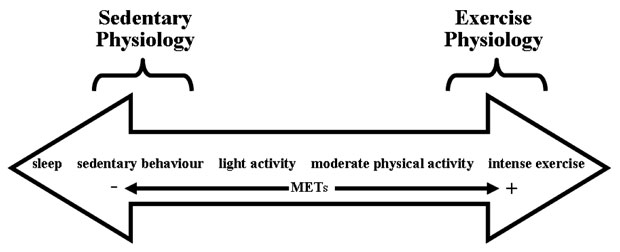
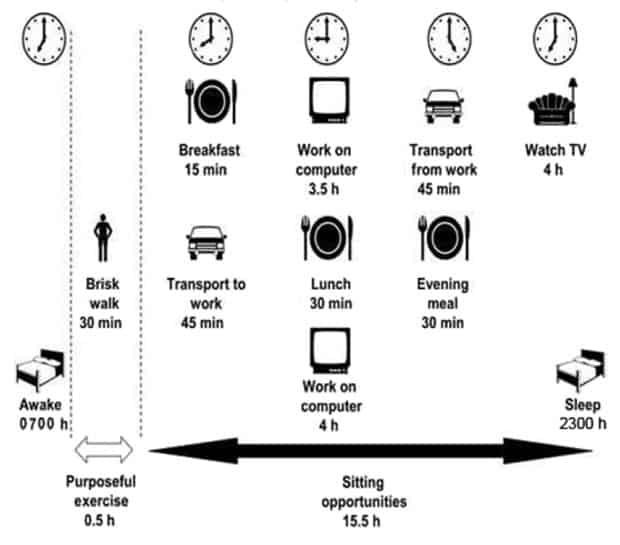
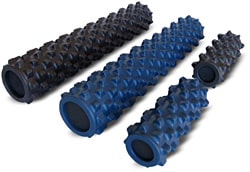


Hi Monica,
Another great contribution.
It appears that steady state, chronic, aerobic exercise may actually be harmful as it increases inflamation, oxidative stress and glycation. Perhaps I missed this – was NEAT compared to anaerobic protocols such as HIIT or tabata?
No, you got that wrong; chronic, aerobic exercise is anti-inflammatory and boosts the endogenous anti-oxidative defense!
Interesting. That puts you and Charles Poliquin in opposition on this issue. I will check his sources and post them. Can you provide evidence to support your position?
Of course, here you got some:
The anti-inflammatory effect of exercise
http://www.jappl.org/content/98/4/1154.full
Regular Physical Exercise as a Strategy to Improve Antioxidant and Anti-Inflammatory Status
http://www.hindawi.com/journals/oximed/2012/741545/
Is Physical Activity Able to Modify Oxidative Damage in Cardiovascular Aging
http://www.hindawi.com/journals/oximed/2012/728547/
Remember, when interpreting exercise studies it is important to distinguish acute vs chronic effects.
Here are a few references that Charles used:
Manna, I., Jana, K., Samanta, P. Intensive Swimming Exercise-Induced Oxidative Stress and Reproductive
Dysfunction in Male Wistar Rats: Protective Role of Alpha-Tocopherol Succinate. Canadian JoXUnal of Applied
Ph\Violog\. April 2004. 29(2), 172-185.
Cakir-Atabek, H., Demir, S., Pinarbassili, R., Bunduz, N. Effects of Different Resistance Training Intensity on
Indices of Oxidative Stress. JoXUnal of SWUengWh and CondiWioning ReVeaUch. September 2010. 24(9), 2491-2498.
Walsh, N., Gleeson, M., et al. Position Statement. Part One: Immune Function and Exercise. E[eUciVe
ImmXnolog\ ReYieZ. 2011. 17, 6-63
Shojaei, E., Farajoy, A., et al. Effect of Moderate Aerobic Cycling on Some Systemic Inflammatory Markers in Healthy Active Collegiate Men. InWeUnaWional JoXUnal of GeneUal Medicine. January 2011. 24(2), 79-84.
Jana, K., Samanta, P., Manna, I., Ghosh, P., Singh, N., Khetan, R., Ray, B. Protective Effect of Sodium
Selenite and Zinc Sulfate on Intensive Swimming-Induced Testicular Gamatogenic and Steroidogenic Disorders in Mature Male Rats. Applied Ph\Violog\, NXWUiWion, and MeWaboliVm. October 2008. 33(5), 903-914.
Marzatico, F., Pansarasa, O., et al. Blood Free Radical Antioxidant Enzymes and Lipid Peroxides Following
Long-Distance and Lactacidemic Performances in Highly Trained and Aerobic and Sprint athletes. JoXUnal of SpoUWV Medicine and Ph\Vical FiWneVV. 1997. 37, 235-239.
Packer, L. Oxidants, Antioxidant Nutrients, and the Athlete. JoXUnal of SpoUWV Science. June 1997. 15(3), 353-363.
Martarelli, D., Verdenelli, M., et al. Effect of a Probiotic Intake on Oxidant and Antioxidant Parameters in Plasma of Athletes During Intense Exercise Training. Cen Micobiolog. June 2011. 62(6), 1689-1696.
Skoluda, N., Dettenborn, L., et al. Elevated Hair Cortisol Concentrations in Endurance Athletes. Pchoneoendocinolog. September 2011. Published Ahead of Print.
Gleeson, Michael. Immune Function in Sport and Exercise. Jonal of Applied Phiolog. February 2007. 103(2), 693-699
Wow, what an article. Thank you Monica for such an informative, in depth look at what NEAT can do in all our lives.
I have chronic fatigue syndrome and put in an enormous effort while exercising but find myself quite exhausted later at day and usually the following. Your info has put a whole new thought process in my head about how this could be negatively affecting my body.
I am a bit of a fidgeter and try to stand while waiting at offices etc, but I will make much more of a conscious effort after reading this.
I can’t wait to read parts 2 & 3.
Thanks for all the effort you put into this, I loved it.
I’m glad to hear that, thanks Cindy.
I will go into practical advice in part 3; one other thing you might want to try is a standing working desk. I’ve had one myself for many years, and I’m finding myself being much more productive standing by my computer than I was sitting. It doesn’t have to be fancy; put your computer on a sturdy box or get a higher desk. Works wonders!
Let out the fidgeter inside you!
Nice post. I like the way you start and then conclude your thoughts. Thanks for this information .
You’re welcome.
Excellent article! Shines a nice bright light on the importance of movement during the day. As a side note, when calculating daily caloric requirements, I’ve always found it hard to calculate my resting metabolic rate (like the formula Will uses in Bodybuilding Revealed – Harris-Benedict?) because of the “activity multiplier”. That multiplier is a bit of a guess based on our perception of how active we are, and it can throw the calculations off quite a bit. I’ve never dialed in on my specific caloric needs, but I found that by paying close attention to my activity level and hunger level that on the days I’m more sedentary I eat less, and when I’m really active, like an afternoon of yard work, I eat more, resulting in no change in body fat. If I do sit around a lot, and eat a lot, like on a holiday trip, then the weight starts going up. I guess a brisk walk after thanksgiving meal is more important than we realized.
While it is true that exercise/physical activity increases appetite, regular exercise/physical activity improves the matching of spontaneous food intake to total expenditure. Thus, with regular exercise/physical activity you are less likely of incurring a positive energy imbalance that could lead to a lot of fat gain over time.
You mean you’re having a hard calculating your daily caloric requirement? Yes, the “activity multiplier” makes a huge different. The best way to find your true daily caloric requirement is to do a food diary of how you typically eat when you’re not losing/gaining weight, and run it thru a nutrition analysis software.
I’d say too much fuss is being made over resting metabolic rate. While resting metabolic rate is interesting to know, at the end of the day, what matters is total energy expenditure and requirement.
Damn, I KNEW I was sitting around too much. I’ve always wondered to myself: I know I exercise enough, but damn, do I sit around a lot too! At work, when home either watching TV or worse yet, gaming downstairs with my friends.. does gaming throw off some of the sedentary influences because its interactive, or am I asking for too much? Ugh… That was an awesome article. I plan to fidget and stand up more. I also find myself standing at home when I’m eating, usually in the kitchen.
Philip
That’s good you’re honest about it. Yes, gaming is better than “dozing” by a soap opera, but the key is to get your but of the couch/chair.
You can easily inject NEAT into your daily life by getting either a stationary bike or mini-stepper in your TV room, and a mini-pedal device in your office. Even though you sit while using a mini-pedal devices, you’re moving your legs, so the “butt-off-the-chair” rule doesn’t apply when pedaling.
I will cover practical NEAT tips in part 3.
Monica, you’re officially my new idol! This is some great stuff.
Thank you 🙂
Monica! Your articles are amazing and highly informational. From a fellow lifter, your body rocks as well . . . just saying.
Thank you.
Wish we could get Parts 2 and 3 🙂 I admit I sit way too much, but hoping for some good advice on the little things. Because just standing more at work isn’t always practical.
It’s coming! 🙂
http://www.trainergize.com
Hi Monica,
This is very interesting stuff. Part one was posted in March. I searched the website for part 2 and 3 and didn’t find anything. I am interested on incorporating NEAT daily, where to find the recommended activities?
Thank you for showing interest in my article.
I haven’t published the other parts yet; but they are in the works…if you want to get notified when I publish them, feel free to sign up for my newsletter at http://www.trainergize.com
Excellent article, thanks for posting this. What’s the best way to ensure I receive a notification when Part 2 is available?
Scratch that last part, just read your reply to Fran about how to get notified for Parts 2 and 3. 🙂
You’re welcome. 🙂
Hi Monica,
This article was fantastic and I passed it on to everyone I knew who would read it. But unless I just didn’t find them, you us a part 2 and 3!
ah, scratch that. I just read the comment above.
Good stuff!
It took me months to convince my workplace to allow “stand-up” workstations. I actually had one made at my expense and they denied my use of it because it didn’t “conform to facility policies”. They finally relented after I shared research articles with management and other employees (they joined the fight!). The compromise consisted of them establishing the product to use and the employees getting a “doctors note”. In other words, it didn’t seem to matter that evidence pointed to higher productivity and energy levels.
Regarding the argument over oxidative stress, check this out: http://nutritionfacts.org/video/enhanced-athletic-recovery-without-undermining-adaptation/
Excellent, excellent, excellent article as always Monica!
Aww, thank you. 🙂
WoW! This is just a great article, well explained and well written, Since two weeks ago I have been thinking about how much time I spent sitting, and i Figure out it was quite a lot, so I decided to leave my car at home twice or three times a week and take the train and walk to my job. When I do this, I add to my days about 1 hour and 30 min of walking and 20 min of standing, I hope it helps, I have been doing it for the past two weeks, and i have seen something different in my moods, Because the days I walk I will be less lazy, I am usually lazy to go to work and drive, but when I walk something changes, I just feel less lazy. About my weight loss I think is too early to see any difference, but maybe with time I will get to see good results. I can wait to read the next articles. Awesome work.
Ps. Sorry If my english isn´t too good, I am native spanish speaker.
I switched to a standing desk at work about 8 years ago. Much healthier than sitting all day.
But even better is that a few years ago I started working from home a couple days/week. First thing I did was set up a treadmill desk (typing this response as I walk). While the output is just a formula it has me burning about 120 cals/hour. I find walking for exercise boring but if I’m working and walking then it’s like I’m getting paid to stay active. BRILLIANT!
I’m guessing Part 2 and 3 of this article isn’t happening.
Boy, does this ever hit me upside the head, Monica! I plead “guilty” on almost all counts. I do, however, engage in some strength training/rehab on a fairly regular basis, but sitting a lot? Yep! I work a lot on the computer doing voice-over auditions and audio engineering (sound editing, basically) and I sometimes forget how long I’ve been sitting. Of course, my lower back and feet manage to set off alarm bells and I have to get up and move around, stretch, etc. Too much sitting just seems to sap my energy and I’m a lot more tired than when I go to the gym for 2 or more hours. Thanks for a real heads-up!
Wonderfully put together. By the way, you look amazing and beautiful.
why can’t I find parts 2&3? 🙁 Great article!!
Emma, you can’t find parts 2 & 3 because Monica never wrote them.